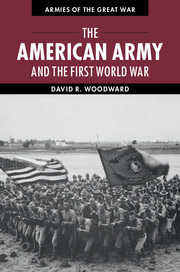Book contents
- Frontmatter
- Dedication
- Contents
- List of figures
- List of maps
- List of tables
- Preface
- List of abbreviations
- Introduction
- 1 Birth of a modern army
- 2 World war and American preparedness
- 3 Coercive power and Wilsonian diplomacy
- 4 “You’re in the army now”
- 5 US army doctrine and industrialized trench warfare
- 6 Over where?
- 7 American Expeditionary Force organization, overseas training, and deployment
- 8 Will the Americans arrive in time?
- 9 Failed expectations: “the military establishment of the United States has fallen down”
- 10 Atlantic ferry
- 11 Neck of the bottle
- 12 Uncertain times
- 13 Cantigny
- 14 Into the breach
- 15 American soldiers in north Russia and Siberia
- 16 The beginning of the end
- 17 Establishment of the American First Army and Saint-Mihiel
- 18 Meuse-Argonne, September 26–October 31
- 19 Breakout, November 1–11
- 20 Epilogue
- Notes
- Bibliography
- Index
14 - Into the breach
Published online by Cambridge University Press: 05 July 2014
- Frontmatter
- Dedication
- Contents
- List of figures
- List of maps
- List of tables
- Preface
- List of abbreviations
- Introduction
- 1 Birth of a modern army
- 2 World war and American preparedness
- 3 Coercive power and Wilsonian diplomacy
- 4 “You’re in the army now”
- 5 US army doctrine and industrialized trench warfare
- 6 Over where?
- 7 American Expeditionary Force organization, overseas training, and deployment
- 8 Will the Americans arrive in time?
- 9 Failed expectations: “the military establishment of the United States has fallen down”
- 10 Atlantic ferry
- 11 Neck of the bottle
- 12 Uncertain times
- 13 Cantigny
- 14 Into the breach
- 15 American soldiers in north Russia and Siberia
- 16 The beginning of the end
- 17 Establishment of the American First Army and Saint-Mihiel
- 18 Meuse-Argonne, September 26–October 31
- 19 Breakout, November 1–11
- 20 Epilogue
- Notes
- Bibliography
- Index
Summary
After the German failure to capture Hazebrouck in April, the unanswered and critical question for Allied leaders was: where would Ludendorff strike next? The responsibility for coming up with the correct answer now rested on the shoulders of General-in-Chief Foch. Believing that Ludendorff would once again strike on the British front, he ordered Pétain to send most of his reserves north to assist Haig. On May 7, 1918 the French commander-in-chief met with him to express his growing concern about concentrating his reserves between the Channel and the Oise River. But Foch did not share his fears and lectured his French comrade: “On the front between the Lys [south of Hazebrouck] and the Oise a German attack of great energy can come at any moment and achieve results that will have the gravest consequences because of the proximity of important objectives.”
The Germans had only to advance eighty kilometers along the Somme to reach the Channel. If the BEF clung to the French Army and retreated south of the Somme it would cut itself off from its key rail centers of Amiens and Hazebrouck and its essential Channel ports of Calais and Dunkirk. Faced with such a bleak prospect London might choose to evacuate its armies to Britain rather than maintain contact with the French Army.
- Type
- Chapter
- Information
- The American Army and the First World War , pp. 233 - 255Publisher: Cambridge University PressPrint publication year: 2014



